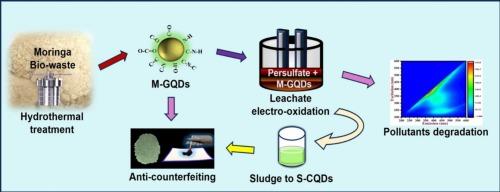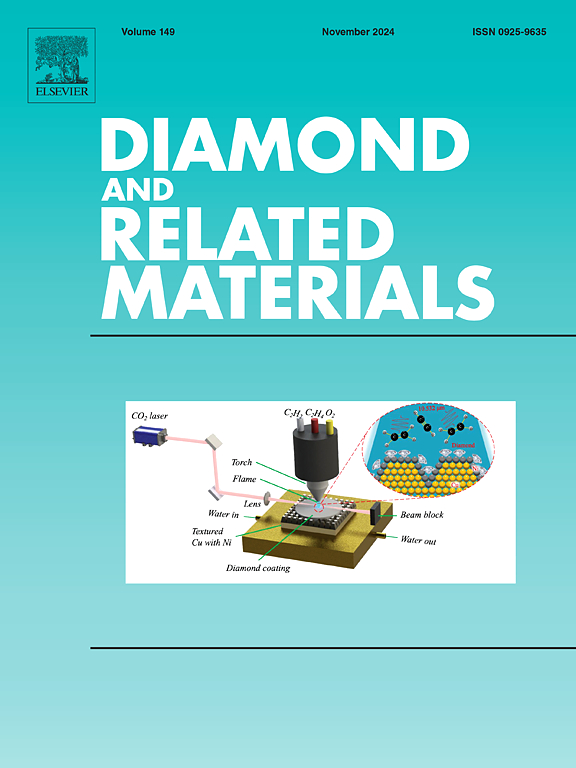Graphene quantum dots/persulfate boosted electro-oxidation for leachate degradation, carbon quantum dots extraction for anti-counterfeiting applications - a sustainable approach
IF 4.3
3区 材料科学
Q2 MATERIALS SCIENCE, COATINGS & FILMS
引用次数: 0
Abstract
Leachate management in an efficient way is still a challenge as it contains many emerging pollutants. This work activates the persulfate by defatted Moringa oleifera seeds waste-derived graphene quantum dots (M-GQDs) catalyst to degrade the matured leachate pollutants by electro-oxidation with scrap stainless steel as electrodes. At the optimized conditions with pH of 3, 4.5 V, 1 g/L of persulfate, 0.07 g/L of M-GQDs, 3 h of reaction time, the removal of UV254, chemical oxygen demand (COD), total organic carbon (TOC), and NH3-N is found to be 99 %, 97 %, 84 %, and 90 % respectively with less energy consumption of 0.44 kWh/kg COD. The 3D fluorescence excitation-emission spectrophotometer (3D EEM) and the Gas chromatography-mass spectroscopy (GC–MS) analysis results attune the degradation of dissolved organic matter and micropollutants in the leachate. From the above-mentioned electro-oxidation treatment generated sludge, the quantum dots (S-CQDs), have been synthesized and characterized. Both the M-GQDs and S-CQDs are green emissive, spherical, and hydrophilic, with an average particle size of 2 to 4 nm, a band gap of 4 eV, and a quantum yield of 3.91 %, & 6.73 % respectively. Both have shown good suitability for information encryption and anti-counterfeiting fingerprint enhancement without changing the latent shape. The work is innovative because it broadens the application of quantum dots to the purification of highly contaminated wastewater and the development of materials for industry from generated waste for a closed-loop sustainability system.

石墨烯量子点/过硫酸盐促进电氧化法降解渗滤液,碳量子点萃取用于防伪应用--一种可持续的方法
由于渗滤液中含有许多新出现的污染物,因此如何有效地管理渗滤液仍是一项挑战。本研究以废旧不锈钢为电极,利用脱脂辣木籽废料衍生的石墨烯量子点(M-GQDs)催化剂激活过硫酸盐,通过电氧化降解成熟的渗滤液污染物。在 pH 值为 3、电压为 4.5 V、过硫酸盐浓度为 1 g/L、M-GQDs 浓度为 0.07 g/L、反应时间为 3 h 的优化条件下,UV254、化学需氧量(COD)、总有机碳(TOC)和 NH3-N 的去除率分别为 99%、97%、84% 和 90%,能耗为 0.44 kWh/kg COD。三维荧光激发-发射分光光度计(3D EEM)和气相色谱-质谱(GC-MS)分析结果表明了渗滤液中溶解有机物和微污染物的降解情况。根据上述电氧化处理产生的污泥,合成了量子点(S-CQDs)并对其进行了表征。M-GQDs 和 S-CQDs 都具有绿色发射性、球形和亲水性,平均粒径为 2 至 4 nm,带隙为 4 eV,量子产率分别为 3.91 %、& 6.73 %。两者都显示出良好的适用性,可在不改变潜伏形状的情况下用于信息加密和指纹防伪增强。这项工作具有创新性,因为它拓宽了量子点的应用范围,将其用于净化高度污染的废水,以及从产生的废物中开发工业材料,以实现闭环可持续发展系统。
本文章由计算机程序翻译,如有差异,请以英文原文为准。
求助全文
约1分钟内获得全文
求助全文
来源期刊

Diamond and Related Materials
工程技术-材料科学:综合
CiteScore
6.00
自引率
14.60%
发文量
702
审稿时长
2.1 months
期刊介绍:
DRM is a leading international journal that publishes new fundamental and applied research on all forms of diamond, the integration of diamond with other advanced materials and development of technologies exploiting diamond. The synthesis, characterization and processing of single crystal diamond, polycrystalline films, nanodiamond powders and heterostructures with other advanced materials are encouraged topics for technical and review articles. In addition to diamond, the journal publishes manuscripts on the synthesis, characterization and application of other related materials including diamond-like carbons, carbon nanotubes, graphene, and boron and carbon nitrides. Articles are sought on the chemical functionalization of diamond and related materials as well as their use in electrochemistry, energy storage and conversion, chemical and biological sensing, imaging, thermal management, photonic and quantum applications, electron emission and electronic devices.
The International Conference on Diamond and Carbon Materials has evolved into the largest and most well attended forum in the field of diamond, providing a forum to showcase the latest results in the science and technology of diamond and other carbon materials such as carbon nanotubes, graphene, and diamond-like carbon. Run annually in association with Diamond and Related Materials the conference provides junior and established researchers the opportunity to exchange the latest results ranging from fundamental physical and chemical concepts to applied research focusing on the next generation carbon-based devices.
 求助内容:
求助内容: 应助结果提醒方式:
应助结果提醒方式:


